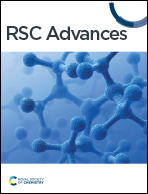Theoretical prediction and design for chalcogenide-quantum-dot/TiO2 heterojunctions for solar cell applications†
Abstract
Quantum dot sensitized solar cells have attracted much attention due to their high efficiency of photoelectric conversion and low manufacturing cost. In this study, a series of heterojunction structures with cubic (MA)4 chalcogenide quantum dots adsorbing on the (001) surface of TiO2 were investigated, in order to explore new quantum dot sensitizers for solar cell applications. Our study revealed that sulfide and selenide quantum dots are more suitable for solar energy harvesting, compared to their oxide counterparts, due to their smaller ionization potentials and smaller HOMO–LUMO (highest occupied molecular orbital-lowest unoccupied molecular orbital) gaps, but in general exhibit weaker adsorption on TiO2. M4A3B and M4A2B2 quantum dots were designed in combination with the advantage of higher adsorption stability and photoelectric conversion capability. Our theoretical predictions for the structurally precise chalcogenide systems suggest a possible direction for the design of quantum-dot sensitized solar cells.



 Please wait while we load your content...
Please wait while we load your content...